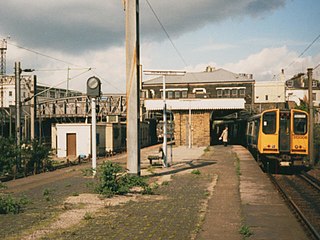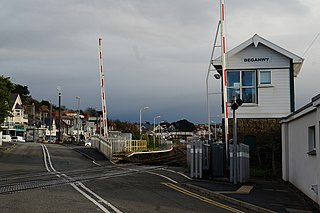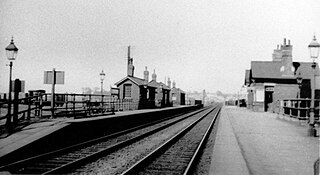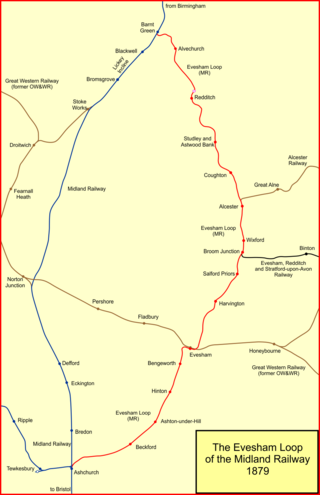
The London and North Western Railway was a British railway company between 1846 and 1922. In the late 19th century, the LNWR was the largest joint stock company in the world.

The Stratford-upon-Avon and Midland Junction Railway (SMJR) was a railway company in the southern Midlands of England, formed at the beginning of 1909 by the merger of three earlier companies:

Harlesden is a Network Rail station on Acton Lane in northwest London, served by London Overground and by London Underground Bakerloo line trains. The railway line here is the border between the Harlesden and Stonebridge residential area in the east, and the Park Royal industrial estate to the west. The southern end of Willesden Brent Sidings separates the station from the West Coast Main Line.

Rugby railway station serves the market town of Rugby in Warwickshire, England. The current station dates from 1885; two previous stations dating from 1838 and 1840 respectively, existed at locations to the west of the current one. It has been Rugby's only station, since the closure of the former Rugby Central station in 1969, on the now-abandoned Great Central Main Line route through the town. Between 1950 and 1970, the station was known as Rugby Midland before reverting to its original title. The station underwent an extensive remodelling between 2006 and 2008; new platforms were added and a new ticket office and entrance building were constructed. The original Victorian part of the station was retained in the upgrade.
The North London Railway (NLR) company had lines connecting the northern suburbs of London with the East and West India Docks further east. The main east to west route is now part of London Overground's North London Line. Other NLR lines fell into disuse but were later revived as part of the Docklands Light Railway, and London Overground's East London Line. The company was originally called the East & West India Docks & Birmingham Junction Railway (E&WID&BJR) from its start in 1850, until 1853. In 1909, it entered into an agreement with the London and North Western Railway which introduced common management, and the NLR was taken over completely by the LNWR in 1922. The LNWR itself became part of the LMS from the start of 1923. The railways were nationalised in 1948 and most LMS lines, including the North London route, then came under the control of the London Midland Region of British Railways.

Primrose Hill was a railway station in Chalk Farm, in the London Borough of Camden, opened by the North London Railway as Hampstead Road in 1855. It was named Chalk Farm from 1862 until 1950, when it was given its final name. From the 1860s to 1915, it was linked with a formerly separate station opened by the London and North Western Railway in 1852. The station closed in 1992, and the platform buildings and canopies were removed in 2008.

The Chiltern Main Line is a railway line which links London (Marylebone) and Birmingham on a 112-mile (180 km) route via High Wycombe, Bicester, Banbury, Leamington Spa and Solihull in England.

Coventry railway station is the main railway station serving the city of Coventry, West Midlands, England. The station is on the Birmingham loop of the West Coast Main Line (WCML); it is also located at the centre of a junction where the lines to Nuneaton and to Leamington converge. It is situated on the southern edge of the city-centre, just outside the Coventry ring road, about 250 yards to the south of junction 6.

Tamworth is a split-level railway station which serves the market town of Tamworth in Staffordshire, England. It is an interchange between two main lines; the Cross Country Route and the Trent Valley section of the West Coast Main Line (WCML). It has four platforms: Two low-level platforms on the WCML, and, at a right-angle to, and passing over these, are two high-level platforms served by the Cross Country Route. Historically there were chords connecting the two lines, but there is no longer any rail connection between them.

Deganwy railway station serves the town of Deganwy, Wales, and is the only intermediate station located on the Llandudno branch line from Llandudno Junction to Llandudno.

Victoria Park was a railway station near Victoria Park, east London, that was on the North London Railway (NLR) which opened in September 1850 to Bow and to the London Docks in January 1852.

Dorridge railway station serves the large village of Dorridge in the West Midlands of England. The station is served by Chiltern Railways, who manage the station, and also by West Midlands Trains. It is situated 10+1⁄2 miles (16.9 km) south of Birmingham Snow Hill.

Solihull railway station serves the market town of Solihull in the West Midlands of England. The station is served by West Midlands Trains and Chiltern Railways. CrossCountry serve the station occasionally to replace stops at Coventry and Birmingham International during engineering work. Solihull used to have a regular Virgin CrossCountry service to Manchester Piccadilly, Blackpool North and Portsmouth Harbour until 2004, when all services through the station were made to run non-stop between Birmingham and Leamington Spa.

Old Hill railway station is in Old Hill, West Midlands, England, on the Birmingham-Stourbridge line. It is managed by West Midlands Trains, who provide the majority of train services; Chiltern Railways also operate a small number.

Willesden railway station was a station about 50 yards (46 m) north of Acton Lane level crossing in Harlesden, Middlesex, opened in 1841 by the London and Birmingham Railway (L&BR) on what became the West Coast Main Line (WCML). It had wooden platforms about 50 yards (46 m) long beside each of the two tracks, a small wooden ticket office with an awning and a coal siding. It was about 3⁄4 mile (1.2 km) south of the original village of Willesden, in what is now the London Borough of Brent. It closed later the same year, reopened in 1844 and closed finally when the L&BR's successor, the London and North Western Railway (LNWR), opened Willesden Junction station about 1⁄2 mile (0.8 km) to the southeast on 1 September 1866. On 15 June 1912 the LNWR opened a new station, known as Harlesden, near the site.

Maxstoke railway station was a railway station opened in 1839 as Coleshill by the Birmingham and Derby Junction Railway on its original route from Derby to Hampton-in-Arden meeting the London and Birmingham Railway for London. The station served the village of Maxstoke and town of Coleshill in Warwickshire, England.

Whitacre Junction railway station was opened in 1864 by the Midland Railway. It served the village of Whitacre Heath, Warwickshire, England.

Lifford railway station refers to a series of railway stations in Cotteridge, Birmingham, England.

Blisworth railway station was a junction station on the London and North Western Railway, the Northampton and Banbury Junction Railway, and the Northampton and Peterborough Railway. As well as providing interchange between the lines, the station served the village of Blisworth in Northamptonshire and its environs. The station was opened by the London and Birmingham Railway (L&BR) in 1838.

The Evesham branch line is a mostly disused English railway line running from Barnt Green via Redditch, Alcester and Evesham to Ashchurch. It was sometimes known as the Gloucester loop line of the Midland Railway.



















